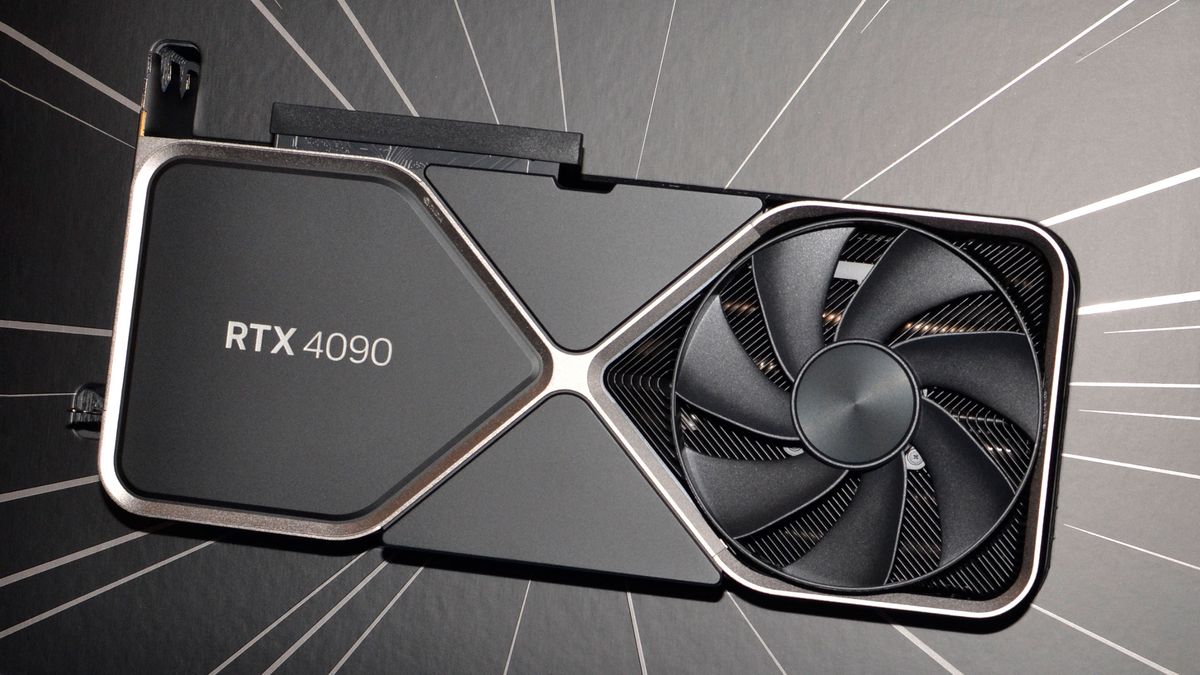Introduction
When it comes to understanding the capabilities of a graphics card, one term that often crops up is “DP.” If you’re not familiar with the world of graphic design or gaming, you might be wondering: what exactly is DP on a graphics card?
DP, short for DisplayPort, is a digital display interface that allows for the connection of monitors, projectors, and other visual output devices to a desktop computer or laptop. It has rapidly gained popularity and become a standard in the industry due to its ability to handle high-resolution graphics and transmit both video and audio signals.
In this article, we will dive deep into the world of DP on a graphics card, exploring its definition, importance, benefits, and utilization in various applications. Whether you’re a graphics enthusiast, a designer, or simply someone looking to upgrade their computer’s visual capabilities, understanding DP on a graphics card is essential for making informed choices.
Definition of DP on a Graphics Card
DisplayPort (DP) is a digital display interface specifically designed to connect graphics cards to visual output devices such as monitors, projectors, and televisions. It was developed by the Video Electronics Standards Association (VESA) as an alternative to existing display standards like VGA and DVI.
Unlike its predecessors, DP is a completely digital interface, allowing for the transmission of high-quality audio and video signals over a single cable. It supports a wide range of resolutions, color depths, and refresh rates, making it suitable for both everyday computing and demanding applications such as gaming and graphic design.
One of the standout features of DP is its ability to support multiple monitors through a process known as daisy chaining. This means that a single DP output on a graphics card can be connected to multiple monitors, eliminating the need for additional ports and cables. This feature is especially appealing to professionals who require a multi-monitor setup for their work.
Additionally, DP has evolved over the years, with each new version introducing improvements and enhanced capabilities. The current version, DisplayPort 1.4, offers support for 8K resolution at 60Hz or 4K resolution at 240Hz, enabling an incredibly smooth and immersive visual experience.
It’s also worth noting that DP is not limited to desktop computers. Many laptops and tablets also come equipped with DP outputs, allowing for seamless connectivity to external displays.
In summary, DP on a graphics card refers to the digital display interface that enables the connection of monitors and other visual output devices. Its ability to transmit high-quality audio and video signals, support multiple monitors, and keep up with the latest display technologies makes it an essential component for an enhanced visual experience on your computer or laptop.
Importance of DP on a Graphics Card
The importance of DisplayPort (DP) on a graphics card cannot be overstated. It plays a crucial role in delivering a superior visual experience, whether you’re using your computer for work or entertainment purposes. Here’s why DP is so important:
1. High-Quality Video and Audio: DP supports high-resolution displays, allowing for crisp and vibrant visuals. It also carries audio signals, eliminating the need for separate audio cables. This ensures a seamless and immersive experience when watching movies, playing games, or editing multimedia content.
2. Versatility: DP is capable of supporting a wide range of resolutions, color depths, and refresh rates. This versatility makes it suitable for various applications, from everyday computing to demanding tasks such as 3D modeling, video editing, and gaming. Whether you’re a professional or a casual user, DP provides the flexibility and performance you need.
3. Multi-Monitor Support: DP enables the connection of multiple monitors through daisy chaining. This feature is extremely beneficial for professionals who require a multi-monitor setup, as it enhances productivity and allows for better multitasking. With DP, you can create an expansive and seamless workspace without the need for additional ports and cables.
4. Future-Proofing: As technology advances, display resolutions and requirements continue to evolve. DP keeps pace with these advancements, ensuring that your graphics card remains compatible with the latest display technologies. By investing in a graphics card with DP capabilities, you can future-proof your setup and avoid the need for frequent upgrades.
5. Simplified Connectivity: DP provides a unified interface for connecting various visual output devices, such as monitors, projectors, and televisions. This simplifies the setup process and reduces cable clutter. Additionally, DP is widely supported by both hardware manufacturers and operating systems, ensuring seamless compatibility and ease of use.
In summary, DP on a graphics card is important because it delivers high-quality video and audio, offers versatility in display options, supports multi-monitor setups, future-proofs your system, and simplifies connectivity. These benefits make DP a fundamental component for graphics enthusiasts, professionals, and casual users who value a superior visual experience on their computers.
DP Standards and Versions
DisplayPort (DP) has undergone several advancements and iterations since its initial release. Each new version introduces improvements in terms of bandwidth, resolution support, and additional features. Let’s take a closer look at the different DP standards and versions:
1. DisplayPort 1.0: This was the first version of DP to be released in 2006. It introduced a digital display interface capable of transmitting high-quality video and audio signals. DisplayPort 1.0 supported a maximum resolution of 2560×1600 pixels and offered a data transfer rate of up to 8.64 Gbps.
2. DisplayPort 1.1: Released in 2007, DisplayPort 1.1 added support for High-Bandwidth Digital Content Protection (HDCP). HDCP is a form of digital copy protection that ensures secure connections between the source and display devices, preventing unauthorized duplication or distribution of copyrighted content.
3. DisplayPort 1.2: This version, introduced in 2009, brought significant improvements in bandwidth and resolution support. DisplayPort 1.2 increased the maximum resolution to 3840×2160 pixels (4K Ultra HD) per display, and with Multi-Stream Transport (MST) support, it allowed for daisy chaining multiple displays with a single cable. It also introduced the High Bit Rate 2 (HBR2) mode, doubling the data transfer rate to 17.28 Gbps.
4. DisplayPort 1.3: Released in 2014, DisplayPort 1.3 further enhanced the capabilities of DP. It increased the maximum display resolution to an astonishing 7680×4320 pixels (8K Ultra HD) at 60Hz or 4K resolution at up to 120Hz. DisplayPort 1.3 also introduced support for Display Stream Compression (DSC), which enables higher resolutions and refresh rates without sacrificing image quality.
5. DisplayPort 1.4: Launched in 2016, DisplayPort 1.4 continued to build upon the advancements of its predecessors. It introduced support for Display Stream Compression 1.2 (DSC 1.2), enabling the transmission of 8K resolution at 60Hz or 4K resolution at up to 240Hz. DisplayPort 1.4 also brought enhancements in High Dynamic Range (HDR) support, providing more vibrant and lifelike colors on compatible displays.
6. DisplayPort 2.0: The latest version of DP, announced in 2019 but not yet widely available, is DisplayPort 2.0. It promises even higher bandwidth and faster data transfer rates, with support for resolutions up to 16K (15360×8460 pixels) at 60Hz, or 10K (10240×4320 pixels) at 120Hz. DisplayPort 2.0 also introduces Forward Error Correction (FEC) for improved error correction and more reliable data transmission.
As future technologies emerge and display requirements evolve, DP will continue to evolve to meet these demands, ensuring compatibility and superior performance.
Benefits of DP on a Graphics Card
DisplayPort (DP) offers numerous benefits when it comes to graphics cards and visual output. Let’s explore some of the key advantages of using DP on a graphics card:
1. High Bandwidth: DP provides higher bandwidth compared to other display interfaces like VGA and DVI. This allows for faster data transfer rates, ensuring smooth and lag-free performance, especially when dealing with high-resolution content or fast-paced gaming.
2. Enhanced Display Quality: DP supports high-resolution displays, including 4K and 8K resolutions. It also offers deep color capabilities, allowing for a wider color gamut and more accurate color reproduction. This results in sharper and more vibrant visuals, bringing your content to life.
3. Audio and Video Integration: Unlike older display standards, DP carries both video and audio signals over a single cable, eliminating the need for separate audio connections. This simplifies the setup process and provides a seamless audiovisual experience.
4. Multi-Monitor Support: DP enables the connection of multiple monitors through daisy chaining. This means you can connect multiple monitors to a single DP output, creating an expansive and seamless workspace. Whether you’re a professional requiring a multi-monitor setup or a gamer who wants an immersive gaming experience, DP offers the flexibility you need.
5. Future-Proofing: DP has evolved with each new version, introducing improvements in resolution support, bandwidth, and additional features. By investing in a graphics card with DP capabilities, you can ensure that your setup is compatible with the latest display technologies and resolutions. This helps future-proof your system and extends its usability.
6. Versatility and Compatibility: DP is widely supported by both hardware manufacturers and operating systems. This ensures that you can easily connect DP-enabled devices to your graphics card without compatibility issues. Additionally, DP adapters are available for connecting DP to other display interfaces, providing flexibility and compatibility with a wide range of devices.
In summary, the benefits of DP on a graphics card include high bandwidth, enhanced display quality, audio and video integration, multi-monitor support, future-proofing, and versatility. These benefits make DP an essential feature for users who want the best visual experience and flexibility in their computing setup.
Applications and Use Cases of DP on a Graphics Card
DisplayPort (DP) on a graphics card has a wide range of applications and use cases, catering to various industries and user needs. Here are some prominent examples of how DP is utilized:
1. Gaming: DP is highly valued by gamers due to its ability to support high resolutions, high refresh rates, and smooth video playback. Gamers can take full advantage of DP’s capabilities to enjoy immersive gaming experiences, where every detail is rendered with exceptional clarity, and fast-paced action is displayed without any visual artifacts or lag.
2. Graphic Design and Video Editing: Professionals in the graphic design and video editing industries rely on accurate color reproduction and precise image rendering. DP’s support for deep color and high-resolution displays ensures that designers and editors can work with confidence, knowing that their work will be accurately represented on the screen.
3. Multi-Monitor Setups: DP’s daisy chaining capability is extremely beneficial for professionals who require multiple displays. Whether it’s for stock trading, financial analysis, or content creation, DP allows for seamless connectivity and flexibility. It simplifies cable management, reduces clutter, and provides a smooth workflow across multiple screens.
4. Multimedia and Home Entertainment: DP’s ability to transmit both video and audio signals over a single cable makes it an ideal choice for multimedia enthusiasts and home entertainment setups. Whether you’re watching movies or streaming content, DP ensures a high-quality audiovisual experience without the need for additional cables or connections.
5. Virtual Reality (VR): VR applications demand high resolutions, low latency, and smooth frame rates to create a believable and immersive virtual experience. DP fulfills these requirements, providing the necessary bandwidth and performance to connect VR headsets and deliver seamless visuals, enhancing the immersion and realism of virtual environments.
6. Professional Displays and Projectors: DP is widely supported by high-end displays and projectors, making it the preferred choice for professionals who require accurate color reproduction and fine details. It offers a reliable and versatile connection to these specialized devices, enabling architects, photographers, and other professionals to showcase their work with utmost precision.
In summary, DP on a graphics card finds applications in gaming, graphic design, video editing, multi-monitor setups, multimedia, virtual reality, and professional displays and projectors. Its versatility and performance make it a go-to interface for industries and use cases that demand superior visual quality and connectivity options.
Factors to Consider When Choosing a Graphics Card with DP
When selecting a graphics card with DisplayPort (DP) capabilities, several factors should be taken into consideration to ensure that you choose the right card for your needs. Here are some key factors to keep in mind:
1. Resolution and Refresh Rate Support: Determine the maximum resolution and refresh rate that the graphics card can handle over DP. If you plan to work with high-resolution displays or require a specific refresh rate for gaming or content creation, ensure that the graphics card can meet those requirements.
2. Number of DP Outputs: Consider the number of DP outputs available on the graphics card. If you require multiple monitors or displays, ensure that the card has sufficient DP outputs or supports daisy chaining.
3. DP Version: Check the DP version supported by the graphics card. Newer versions, such as DisplayPort 1.4, provide enhanced bandwidth, support for higher resolutions, and additional features. Opting for a graphics card with the latest DP version helps future-proof your setup.
4. GPU Performance: Consider the overall performance of the graphics card, including its GPU capabilities, memory, and processing power. This is especially important if you plan to use the card for demanding applications like gaming, 3D modeling, or video editing. Look for a balanced combination of performance and DP capabilities.
5. Compatibility: Ensure that the graphics card is compatible with your system’s hardware, such as the motherboard, power supply, and available PCIe slots. Additionally, check for compatibility with your operating system and driver support to avoid any compatibility issues.
6. Budget: Set a budget for your graphics card purchase and consider the cost-effectiveness of the options available. Compare the features, performance, and DP capabilities of different cards within your budget to make an informed decision.
7. Brand and Warranty: Consider the reputation and reliability of the graphics card manufacturer. Look for brands known for their quality products and good customer support. Additionally, check for warranty coverage to protect your investment in case of any issues.
By considering these factors, you can select a graphics card with DP capabilities that align with your specific requirements, ensuring a smooth and high-quality visual experience for your computing needs.
Conclusion
DisplayPort (DP) on a graphics card plays a crucial role in delivering high-quality visuals, seamless connectivity, and versatile display options. Whether you’re a gamer, graphic designer, or multimedia enthusiast, understanding the importance and benefits of DP is essential for making informed decisions when choosing a graphics card.
DP offers significant advantages over older display interfaces, including higher bandwidth, support for high resolutions and refresh rates, audio and video integration, multi-monitor capabilities, and future-proofing. These benefits make DP a fundamental component for those seeking enhanced visual experiences, productivity, and compatibility.
When choosing a graphics card with DP, consider factors such as resolution and refresh rate support, number of DP outputs, DP version, GPU performance, compatibility, budget, and brand reputation. Taking these factors into account will ensure that you select a graphics card that meets your specific needs and provides a seamless and immersive visual experience for your chosen applications.
As technology continues to advance, DP will continue to evolve, offering even more advanced features and capabilities. Keeping up with the latest DP versions and standards ensures compatibility with future display technologies and enables you to stay ahead in the fast-paced world of visuals.
In conclusion, DP on a graphics card is a vital aspect of modern computing, providing the necessary infrastructure for superior visual experiences. By understanding and leveraging the power of DP, you can elevate your gaming, design, multimedia, and productivity endeavors to new heights, all while enjoying the convenience and flexibility that DP offers.

























